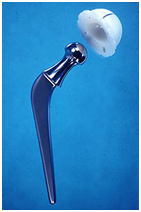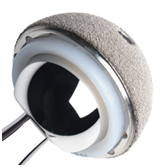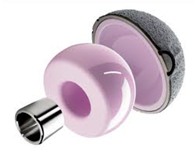At the heart of every hip replacement is the bearing, or ball and socket joint. Originally the bearing choice was very simple. You could only have a metal femoral head (or ball) on polyethylene cup (or socket) bearing. This was the bearing that English orthopaedic surgeon, Sir John Charnley settled upon when he popularised total hip replacement in the 1960’s. Over the following two decades it became clear that despite the great benefits of hip replacement, there were problems related to wear of the implant, particularly in younger or higher demand patients. This wear would often lead to debris within the prosthetic joint. As wear debris accumulated, the body produced inflammatory cells in an effort to neutralise the effects of the wear particles. This inflammatory response then lead to prosthetic loosening, which could cause pain and loss of function for the patient.
Recognising the problems associated with wear, the orthopaedic industry has developed newer bearing materials in the hope of delivering longer life implants. I have summarised the current options for most patients below.
- Metal Head on Highly cross linked polyethylene (HXLPE). This combination of bearing surface is now highly durable and offers predictable long term function out to at least 15 years. The wear debris generated is much less than the original technology and is an excellent choice for most patients requiring hip replacement.
- Ceramic head on HXLPE. This option combines the very smooth and hard properties of a ceramic head on the proven HXLPE. Wear rates are better than metal on polyethylene, particularly if there is other debris in the hip joint. Because the ceramic is so hard, it is difficult to scratch, making this combination very wear resistant. Past concerns regarding cracking or fracture of the ceramic head have largely disappeared due to advances in manufacturing technology. This option is suitable for patients with moderate to high demands and an expected lifespan of 20+ years.
- Ceramic head on ceramic liner. This combination has the lowest of all wear rates. The wear debris generated is so low that it is hard to record, even in hip simulator studies. It is, however, more susceptible to poor alignment and has the disadvantage of potentially causing ‘squeaks’, or noise due to loss of lubrication. Even if the implant does wear, the products of that wear do not appear to cause the inflammatory response that happened with the polyethylene bearings. This bearing combination is most suited to younger patients with life expectancy over 30 years.
- Metal head on metal socket. Recently, there has been a lot of publicity around ‘faulty hip replacements’. Many of these replacements were metal on metal hips. As a result of the problems associated with this type of bearing it is rarely used in Australia. Most companies have withdrawn this technology from sale. Most of the problems occurred as a result of fine metallic particles causing an inflammatory response, often causing pain, loosening and bone damage. This bearing combination is not recommended.
 Charnley Total Hip Replacement
Charnley Total Hip Replacement Metal on Highly Cross Linked Polyethylene (HXLPE)
Metal on Highly Cross Linked Polyethylene (HXLPE) Ceramic on ceramic bearing
Ceramic on ceramic bearing

